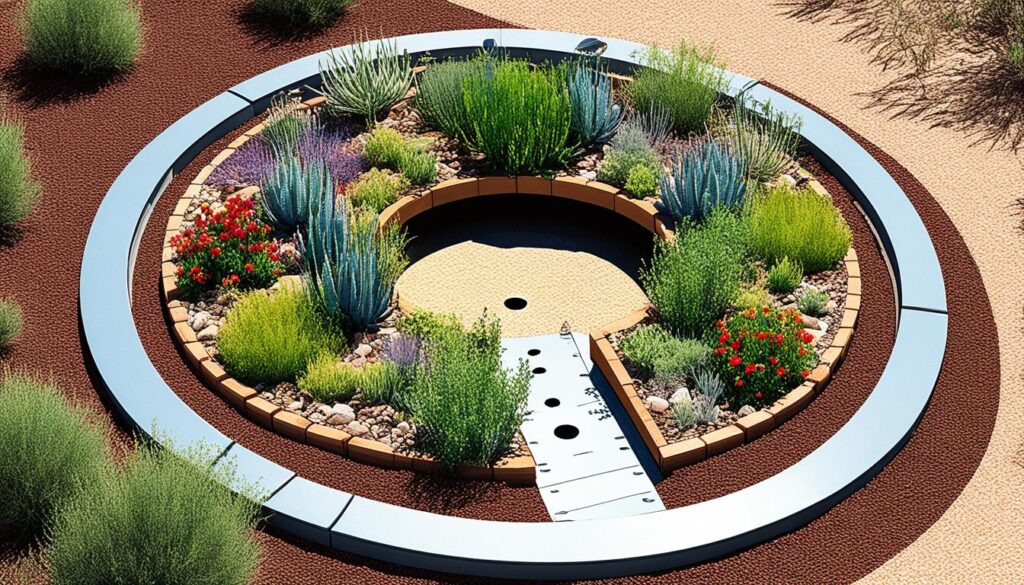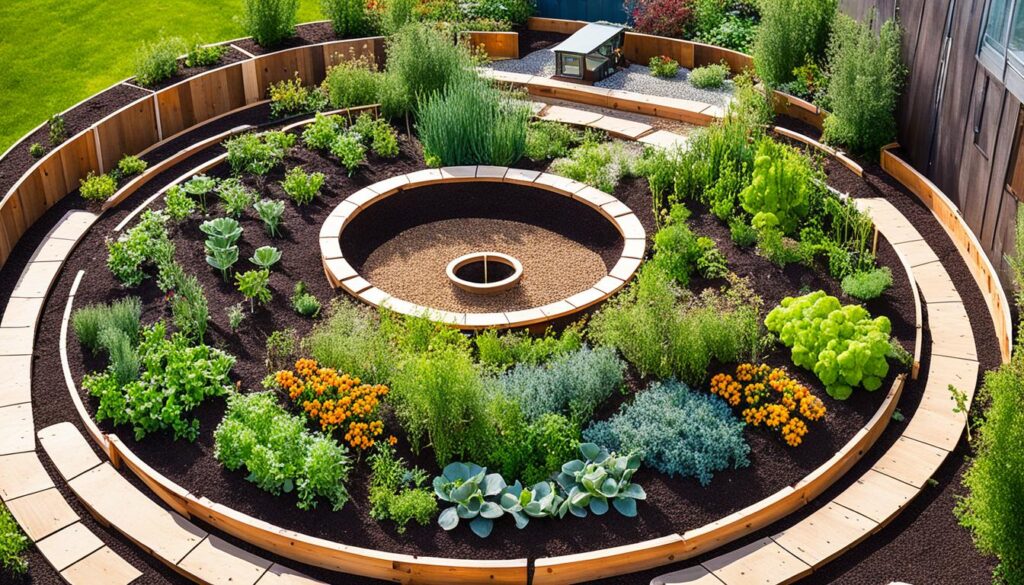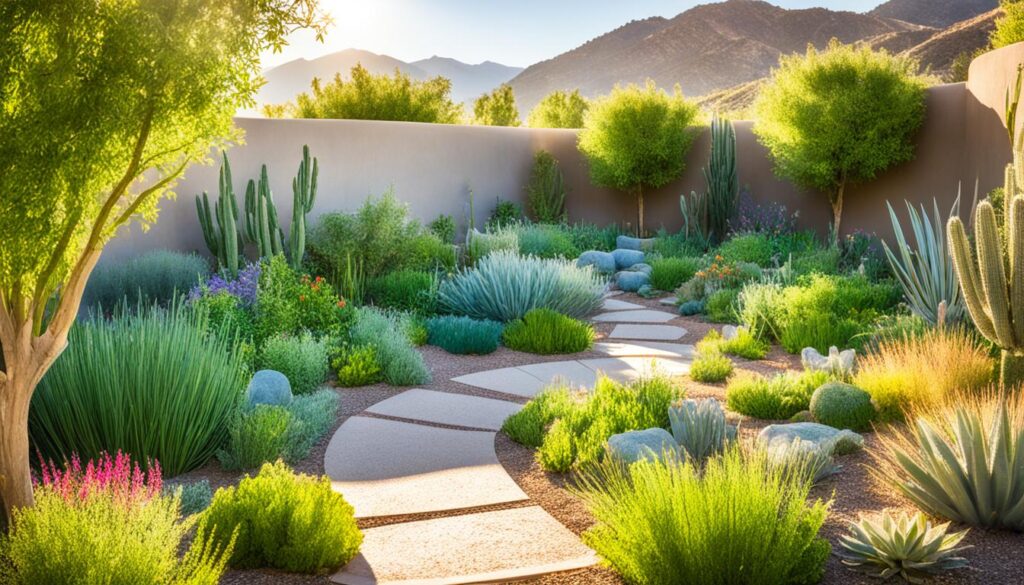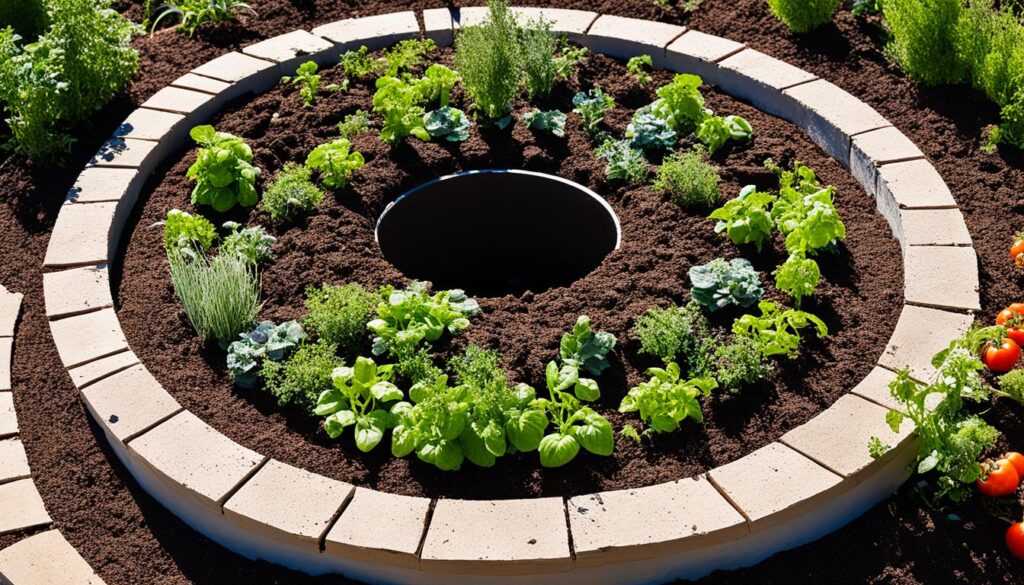
Prescott gardening fans face special challenges in Arizona’s dry climate. Saving water is key, making sustainable gardening a must. The keyhole garden is a smart choice for those wanting to grow food with less water.
These smart garden designs offer hope for Prescott’s garden lovers. They mix clever design with ways to save water. Keyhole gardens are great for gardening in dry places. They help plants grow well with less water, helping gardeners and the planet.
Let’s dive into keyhole gardens and see how they can make your backyard a lush oasis. Get ready to learn how to garden efficiently with less water in Prescott’s tough climate.
Key Takeaways
- Keyhole gardens are ideal for water conservation in Prescott
- These designs support sustainable gardening practices
- Arid climate gardening challenges can be overcome with keyhole gardens
- Prescott gardening benefits from water-efficient structures
- Keyhole gardens combine clever design with eco-friendly techniques
Sustainable Keyhole Gardening for Water-Wise Prescott
Keyhole gardens are a smart way to garden in Prescott’s dry climate. They have a special design with a notch for easy access to a composting basket in the middle. This design helps save water and supports sustainable gardening.
The design of a keyhole garden is easy but works well. It has a raised bed, 6 feet wide, around a central wire mesh column. This column is for composting and feeding nutrients to the soil. The sloped design ensures water goes to the center, moistening the soil.
For people in Prescott, keyhole gardens offer many benefits:
- Water conservation through reduced evaporation and runoff
- Improved soil fertility from ongoing composting
- Extended growing seasons due to raised bed design
- Accessibility for gardeners with limited mobility
Using keyhole gardens, Prescott homeowners can create gardens that use less water and are good for the desert. This gardening method saves water and supports a sustainable way of landscaping in our desert. This article is pure gold—don’t hesitate to read it.
The History and Origins of Keyhole Garden Design
Keyhole gardens are based on African gardening methods, which mix permaculture with sustainable farming. This design was created to help grow food in tough African conditions.
African Roots: The Birth of Keyhole Gardens
In the 1990s, aid workers in Lesotho made keyhole gardens. They wanted to help communities grow food in hard places. These gardens were based on African raised-bed designs. They were made to save water and grow more food.

Global Adoption and Adaptation
Keyhole gardens became popular worldwide after their success in Africa. People all over started using this method, changing it for their own places. Its ability to adapt made it popular in permaculture.
Keyhole Gardens in Arid Regions: A Perfect Match
Places like Prescott found keyhole gardens very useful. They save water, which is great for dry areas. By reducing water loss and keeping nutrients in, keyhole gardens are perfect for growing food in places with little water.
Now, keyhole gardens show how old wisdom and new sustainable ways can work together. They’re a smart, effective way to grow food and save water.
Understanding the Keyhole Garden Structure
Keyhole gardens combine raised bed gardening with a circular design for a unique growing space. From above, they look like keyholes, which makes them stand out.
The raised bed is the garden’s outer wall. It’s made from materials like stones, bricks, or wood. This design helps with drainage and keeps the soil warm, perfect for many plants.
In the garden’s center is a composting basket. It’s a tall cylinder that’s key to the garden’s composting. Here, you put kitchen scraps, yard waste, and water. As these items break down, they feed the soil with nutrients and moisture.
The wedge-shaped path leads to the composting basket. It makes the garden look like a keyhole and makes it easy to care for plants and add compost.
This design combines raised bed gardening with efficient composting. It creates a sustainable, water-saving garden. It’s ideal for dry places like Prescott.
Water Conservation Benefits of Keyhole Gardens in Prescott
Keyhole gardens are great for saving water in Prescott’s dry climate. They help with drought gardening and are perfect for those who want to save water.
Reduced Evaporation and Water Runoff
Keyhole gardens are designed to lose less water to evaporation. They are circular and raised, protecting the soil from the sun and wind. This keeps water in the soil longer, so plants need less water.

Efficient Water Distribution System
Keyhole gardens have a special feature in the middle – a composting basket. When you water the compost, it feeds nutrients to the soil around it. This way, plants get exactly what they need without wasting water.
Maximizing Water Retention in Soil
Keyhole gardens are great at keeping the soil moist. They have layers of organic stuff that hold and slowly release water to the roots. This helps them survive dry spells in Prescott. It means you don’t have to water as much, making them perfect for gardeners who care about water.
- Layers of organic material act like a sponge
- The composting center continuously feeds moisture to the soil
- Sloped design directs water toward plant roots
Keyhole gardens are a smart choice for Prescott’s tough climate. They save water and are a sustainable way to grow food. They follow the principles of water-wise gardening.
Soil Health and Composting in Keyhole Gardens
Keyhole gardens are great for improving soil health with smart composting. The central basket is a key spot for organic gardening, adding nutrients to the soil. This design helps nutrients cycle back into the garden, perfect for Prescott’s climate.
To keep your soil healthy, follow these composting tips:
- Layer green and brown materials in the central basket
- Add kitchen scraps and yard waste regularly
- Keep the compost moist but not waterlogged
- Turn the compost every few weeks to speed up decomposition
As compost breaks down, it adds nutrients to the garden bed. This boosts soil fertility naturally, cutting down on chemical fertilizers. Your garden will grow strong plants and hold water better.
Prescott gardeners can adjust composting for local weather. In dry times, add more moisture to the compost. In the cold, use a straw to keep the compost warm.
Learning these organic gardening tips makes a system that gives you rich soil every year. This not only helps your garden grow better but also makes the environment healthier.
Designing Your Keyhole Garden for Prescott’s Climate
Creating a keyhole garden in Prescott requires careful planning. This design is great for saving water and fits our dry climate. Let’s look at important things to consider when making your keyhole garden.
Choosing the Right Location
Find a spot that gets a lot of sunlight and drains well. Stay away from places that flood or get hit by strong winds. A spot facing south is usually best because it gets the most sun for your plants.

Optimal Size and Shape Considerations
The usual size for a keyhole garden is about 6 feet wide. This size makes it easy to reach all parts of the garden. The keyhole shape lets you get to the compost basket in the middle, which is key to the garden’s success.
Materials Selection for Durability and Sustainability
Pick materials that can handle Prescott’s weather and are good for the planet. Good choices include local stones, recycled bricks, or untreated wood. These materials fit well with the local climate and make your garden last longer.
- Stones: Durable and blend with the natural landscape
- Recycled bricks: Eco-friendly and heat-retaining
- Untreated wood: Affordable but may need replacement sooner
By keeping these points in mind, you’ll make a keyhole garden that does well in Prescott’s climate. It will also support sustainable gardening.
Plant Selection for Keyhole Gardens in Prescott
Choosing the right plants for your keyhole garden in Prescott is crucial. The dry climate means you need plants that can handle little water. Native plants are great because they’re made for the local weather and need less care.
Some top drought-resistant plants for Prescott keyhole gardens are:
- Lavender
- Sage
- Rosemary
- Yarrow
- Agave
Native plants like penstemon, yucca, and desert marigolds look great and draw in bees. They do well in Prescott’s tough weather.
Companion planting is a clever way to use space in keyhole gardens. It helps plants grow better together. Try putting tomatoes with basil for better taste and fewer pests. Plant marigolds near veggies to keep away bad bugs.
Put plants that need the same amount of water together. This helps use water wisely and stops overwatering plants that can’t handle it. With the right plants, your keyhole garden will do great all year in Prescott.
Step-by-Step Guide to Building a Keyhole Garden
Creating a keyhole garden is a fun DIY project that is great for Prescott’s climate. It’s a way to use water and space efficiently, and it’s good for the environment.
Preparing the Ground and Layout
First, pick a spot that gets plenty of sunlight and is level. Draw a circle about 6 feet wide. Remove any grass and rocks to get ready for your garden.
Constructing the Outer Wall and Central Basket
Use rocks or recycled bricks for the outer wall. Make a keyhole shape for easy access. Put a wire mesh basket in the middle for your compost bin. This basket will help feed the soil around it.
Layering and Filling the Garden Bed
Start with cardboard at the bottom of your garden bed. Add twigs, leaves, and compost on top. Finish with rich soil. This layering helps with water and nutrients, making your garden thrive.
Yavapai Landscaping Prescott offers free quotes for landscaping and tree services in Prescott and its surrounding areas. This includes tree removal, trimming, stump grinding, land clearing, storm cleaning, and emergency tree service.
